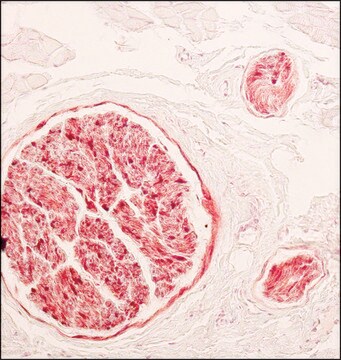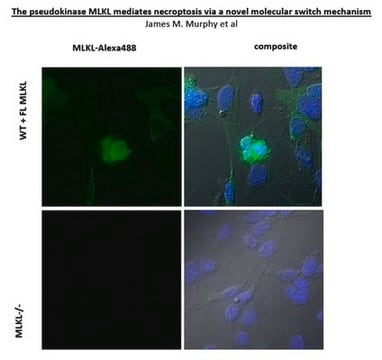추천 제품
생물학적 소스
mouse
Quality Level
항체 형태
purified from hybridoma cell culture
항체 생산 유형
primary antibodies
클론
SH-B1, monoclonal
종 반응성
cat, rabbit, porcine, bovine, rat, human
농도
~1 mg/mL
기술
immunohistochemistry: 1.5-3 μg/mL using immunoperoxidase labeling of pronase digested, formalin-fixed, paraffin-embedded sections of rabbit tongue.
동형
IgG1
배송 상태
dry ice
저장 온도
−20°C
타겟 번역 후 변형
unmodified
유전자 정보
human ... S100B(6285)
일반 설명
Monoclonal Anti-S-100 (β-subunit) (mouse IgG1 isotype) is derived from the SH-B1 hybridoma produced by the fusion of mouse myeloma cells and splenocytes from an immunized mouse. S-100 is a set of small, thermolabile, highly acidic homo or hetero-dimer calcium binding proteins. The protein exists in two isoforms namely, S-100α and S-100β, which are brain specific.
S-100β is a calcium binding protein. It is mainly present in astrocytes and neurons of hindbrain and spinal cord.
면역원
Purified bovine brain S-100β
애플리케이션
Monoclonal Anti-S-100 (β-Subunit) antibody produced in mouse has been used in:
- immunohistochemistry
- enzyme linked immunosorbent assay (ELISA) (Ca2+ ion independent)
- immunocytochemistry
- immunoblotting
- dot blot
- immunohistochemistry.
생화학적/생리학적 작용
S-100 is involved in cell-growth regulation, increasing membrane permeability to cations, inflammatory response in many brain diseases, including schizophrenia, stimulation of nucleolar RNA polymerase activity and transporting proteins and free fatty acids in adipocytes. S-100β tissue distribution can be a useful tool in the differential diagnosis of neoplasms and proliferative processes.
S-100β protein interacts with synaptic, cytoskeletal and cell cycle proteins. Additionally, it can regulate calcium levels in glial and neuronal cells. It is involved in neuronal plasticity, astrogliosis and neuronal cell survival. S-100β is associated with Alzheimer disease and amyotrophic lateral sclerosis.
면책조항
Unless otherwise stated in our catalog or other company documentation accompanying the product(s), our products are intended for research use only and are not to be used for any other purpose, which includes but is not limited to, unauthorized commercial uses, in vitro diagnostic uses, ex vivo or in vivo therapeutic uses or any type of consumption or application to humans or animals.
Not finding the right product?
Try our 제품 선택기 도구.
Storage Class Code
10 - Combustible liquids
Flash Point (°F)
Not applicable
Flash Point (°C)
Not applicable
시험 성적서(COA)
제품의 로트/배치 번호를 입력하여 시험 성적서(COA)을 검색하십시오. 로트 및 배치 번호는 제품 라벨에 있는 ‘로트’ 또는 ‘배치’라는 용어 뒤에서 찾을 수 있습니다.
A Migheli et al.
Neuroscience letters, 261(1-2), 25-28 (1999-03-19)
Amyotrophic lateral sclerosis (ALS) is a neurodegenerative disease characterized by progressive motor neuron loss and astrogliosis. We studied the immunohistochemical expression of S-100beta, a calcium-binding protein with both neurotrophic and neurotoxic activities, in the spinal cord of patients with ALS.
Postnatal activation of TLR4 in astrocytes promotes excitatory synaptogenesis in hippocampal neurons
Shen Y, et al.
The Journal of cell biology, 215(5), 719-734 (2016)
Yan Guo et al.
Signal transduction and targeted therapy, 9(1), 32-32 (2024-02-14)
The appropriate and specific response of nerve cells to various external cues is essential for the establishment and maintenance of neural circuits, and this process requires the proper recruitment of adaptor molecules to selectively activate downstream pathways. Here, we identified
Marc Oria et al.
Frontiers in molecular neuroscience, 15, 888351-888351 (2022-07-06)
During embryonic spinal cord development, neural progenitor cells (NPCs) generate three major cell lines: neurons, oligodendrocytes, and astrocytes at precise times and locations within the spinal cord. Recent studies demonstrate early astrogenesis in animal models of spina bifida, which may
Yi Shen et al.
The Journal of cell biology, 215(5), 719-734 (2016-12-07)
Astrocytes are critical in synapse development, and their dysfunction in crucial developmental stages leads to serious neurodevelopmental diseases, including seizures and epilepsy. Immune challenges not only affect brain development, but also promote seizure generation and epileptogenesis, implying immune activation is
자사의 과학자팀은 생명 과학, 재료 과학, 화학 합성, 크로마토그래피, 분석 및 기타 많은 영역을 포함한 모든 과학 분야에 경험이 있습니다..
고객지원팀으로 연락바랍니다.








